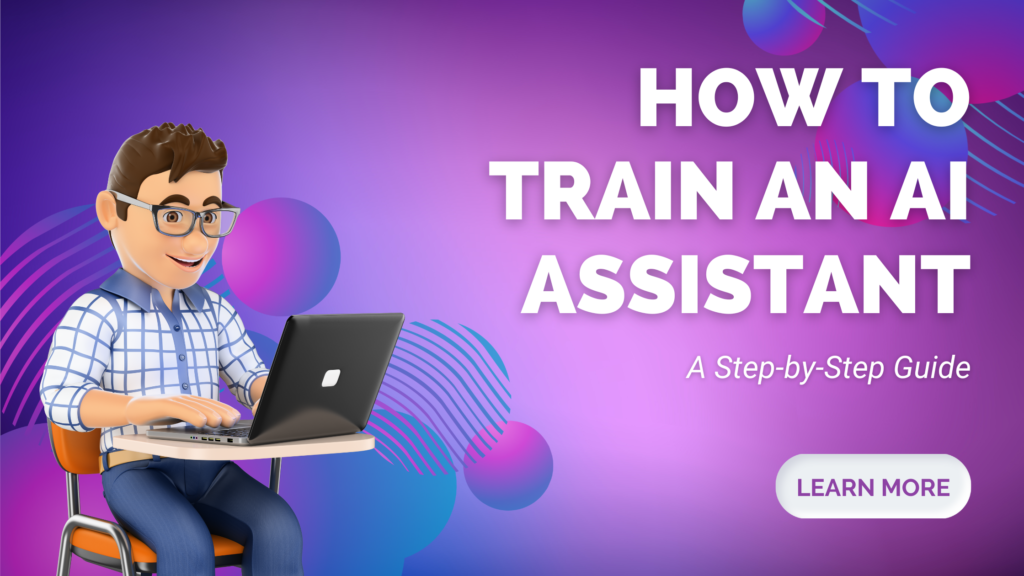How to Train an AI Assistant: A Step-by-Step Guide

What is an AI Assistant and How Does It Work?
An AI assistant is a software program designed to perform tasks, answer questions, and provide services based on user input, often using natural language processing (NLP). AI assistants can handle a wide range of functions, from scheduling appointments to providing personalized recommendations. They work by analyzing input (voice, text, etc.), processing it using advanced machine learning models, and then generating a relevant output or action. AI assistants, like Siri, Alexa, or Google Assistant, use machine learning, NLP, and data analysis to improve their performance over time based on interactions.
How to Build Your Own AI Assistant from Scratch?
To build an AI assistant from scratch, follow these steps:
#1. Define the Scope:
Decide what tasks your AI assistant will perform (e.g., customer service, personal scheduling).
#2. Choose a Platform and Tools:
Select the right tools and frameworks. Common platforms include TensorFlow, OpenAI GPT, and Rasa for building AI models, and cloud services like AWS or Google Cloud for hosting.
#3. Collect and Preprocess Data:
Your assistant will need training data to learn. This can include text data (for chatbots) or voice data (for voice assistants).
#4. Build a Natural Language Processing (NLP) Model:
Use machine learning techniques to enable your assistant to understand and generate human language. Models like BERT, GPT, or LSTM networks are commonly used.
#5. Implement Machine Learning Algorithms:
Use algorithms to train the assistant on how to respond to different queries or actions.
#6. Develop a User Interface:
Create the interface (text or voice) through which users will interact with the assistant.
#7. Test and Deploy:
Thoroughly test your assistant to ensure it can handle the expected queries, and then deploy it using cloud platforms or on-premise servers.
What are the Key Steps in the AI Training Process?

Training an AI assistant is simpler with Task Virtual’s support. Start by defining the AI’s purpose—whether for customer service, administrative tasks, or specialized support—by working with Task Virtual to clarify roles and objectives. Next, gather relevant data and scripts; Task Virtual can organize and format this content efficiently. Finally, test and refine the AI’s responses, using Task Virtual’s team to monitor and tweak its performance until it meets your standards.
#1. Data Collection:
Gather high-quality and relevant data for training. For an AI assistant, this could be language data, task-specific data, or interaction patterns.
#2. Data Preprocessing:
Clean and organize the data. This involves tokenizing text, handling missing values, normalizing data, etc.
#3. Model Selection:
Choose the appropriate machine learning model (e.g., transformers for NLP tasks).
#4. Training the Model:
Feed the processed data into the model and fine-tune it through backpropagation and optimization techniques.
#5. Evaluation and Validation:
Measure the model’s performance using metrics like accuracy, precision, recall, and F1-score, then adjust accordingly.
#6. Iteration:
Continuously improve the model by retraining it with updated data and refining its parameters.
How to Enhance Your AI Assistant’s Capabilities?

To enhance your AI assistant’s capabilities, you can leverage a range of powerful tools and techniques. First, learn how to create a chatbot that specializes in creating AI solutions tailored to your needs. By utilizing software development frameworks and platforms like Microsoft Azure, you can build an AI assistant to handle various tasks, such as smart home management or customer inquiries. This involves integrating pre-built models that allow the AI to perform actions based on voice commands or text inputs.
Furthermore, the key to a successful AI support to understand user intent lies in optimizing the user experience. By customizing your assistant to meet specific user needs, you can ensure a smooth interaction that exceeds expectations. Utilizing data analytics tools allows your assistant can provide insights from large volumes of information, helping it assist customers more effectively and efficiently. Focus on creating applications like chatbots that can dynamically adapt to user preferences and behavior, thus enhancing their overall functionality.
What Are the Best Practices for Developing an AI Assistant?
To create your AI assistant, it’s crucial to follow best practices that enhance its performance and usability. First, selecting the right technology stack is essential, as it determines how well your AI assistant can handle various tasks. You can leverage AI technology to implement cutting-edge AI solutions that enable your assistant to understand user queries effectively. Utilizing pre-trained models, like ChatGPT or GPT-4o, allows you to focus on fine-tuning the assistant to meet specific needs.
Next, training your AI involves using data to help the assistant learn and improve its responses over time. Implementing conversational AI techniques will enable your assistant to provide a more engaging customer experience. Additionally, personalization features can enhance your AI assistant by tailoring interactions based on user preferences. Finally, remember that AI assistants may specialize in creating AI-powered chatbots that can perform tasks across various platforms, allowing them to adapt to diverse user needs.
Why Go To TaskVirtual For AI Assistance?

TaskVirtual can simplify the process of creating your own AI assistant for specific tasks. It can help define the assistant’s purpose, research suitable platforms like OpenAI or TensorFlow, and manage data collection for training. Task Virtual can assist in integrating APIs, organizing workflows, and handling testing and debugging. Additionally, it supports ongoing updates and improvements to ensure the AI remains efficient and aligned with your goals. By managing these operational details, TaskVirtual lets you focus on designing a functional and effective AI assistant.
Next, integrate the AI into your existing systems or software through an API. This step enables your custom AI to seamlessly automate routine tasks, saving you valuable time. By building your AI around a conversational framework, you can create a virtual assistant that specializes in specific areas, such as customer service or data analysis. The power of AI can significantly enhance the effectiveness of your AI virtual assistant, making it a valuable addition to your toolkit.





